Bachelor of Business (Business Management): Rio Tinto HRM Report
VerifiedAdded on 2022/10/18
|12
|3018
|298
Report
AI Summary
This report provides a comprehensive analysis of Rio Tinto's Human Resource Management (HRM) strategies. It begins with an overview of the company, its objectives, and current business performance. The core of the report examines Rio Tinto's HRM strategies, including recruitment and selection processes, performance management systems, employee benefits packages, and employee engagement initiatives. It also details the company's training and development programs. The report then offers a critical analysis, comparing Rio Tinto's practices with those of BHP Billiton, another major mining industry player. Finally, the report concludes with recommendations for future application, including the implementation of Six Sigma and other performance management tools, along with suggestions for enhancing employee engagement and development programs, providing a performance management cycle and root cause analysis for improvement.
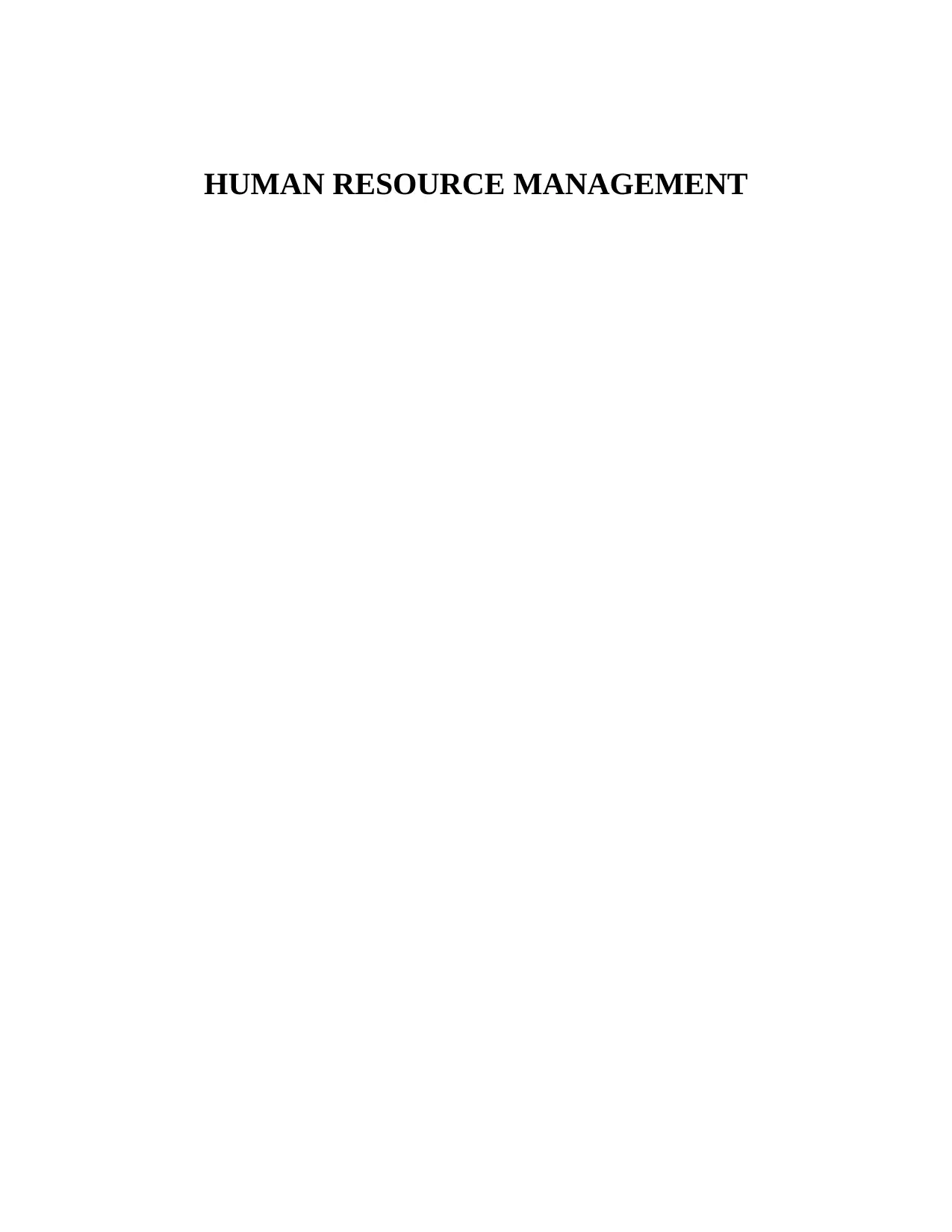
HUMAN RESOURCE MANAGEMENT
Paraphrase This Document
Need a fresh take? Get an instant paraphrase of this document with our AI Paraphraser
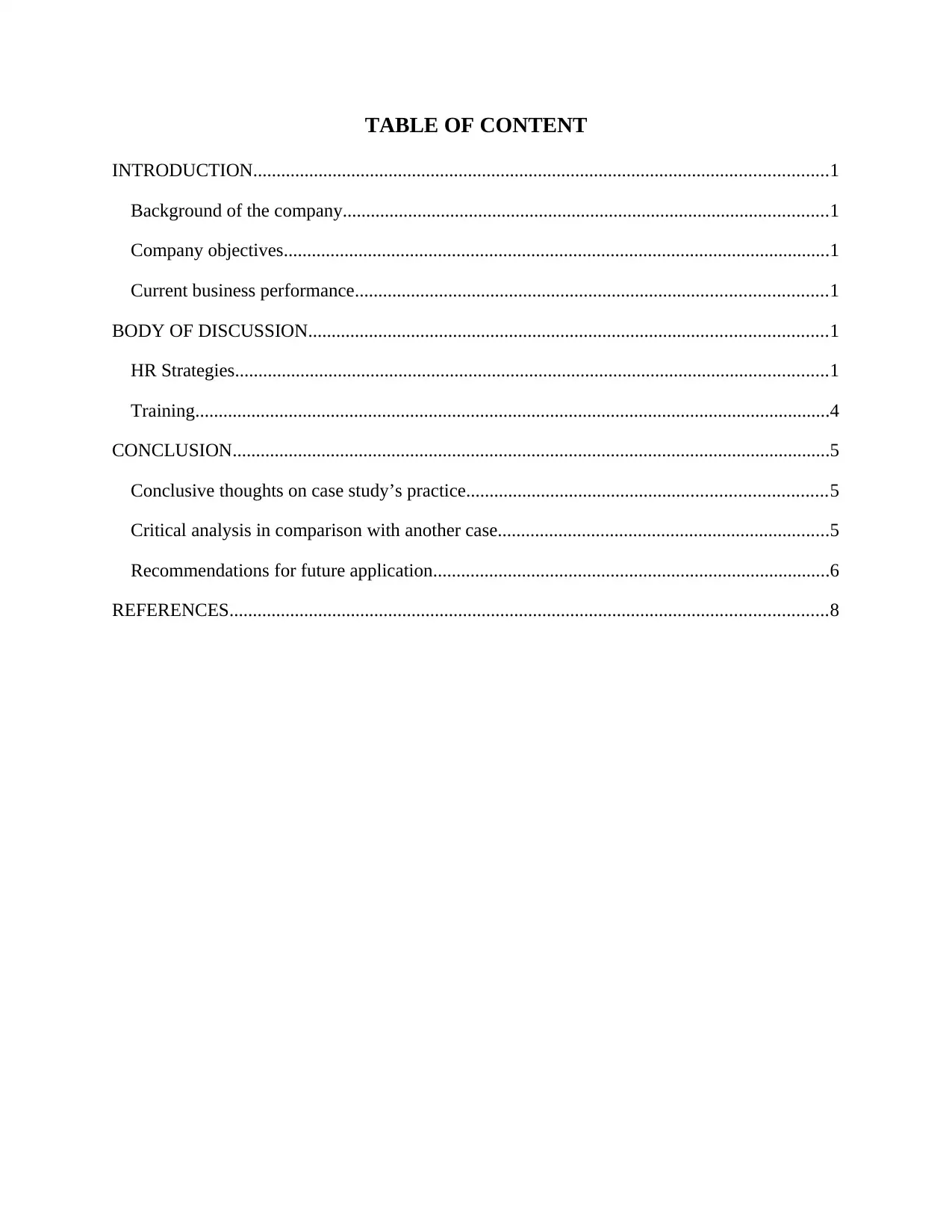
TABLE OF CONTENT
INTRODUCTION...........................................................................................................................1
Background of the company........................................................................................................1
Company objectives.....................................................................................................................1
Current business performance.....................................................................................................1
BODY OF DISCUSSION...............................................................................................................1
HR Strategies...............................................................................................................................1
Training........................................................................................................................................4
CONCLUSION................................................................................................................................5
Conclusive thoughts on case study’s practice.............................................................................5
Critical analysis in comparison with another case.......................................................................5
Recommendations for future application.....................................................................................6
REFERENCES................................................................................................................................8
INTRODUCTION...........................................................................................................................1
Background of the company........................................................................................................1
Company objectives.....................................................................................................................1
Current business performance.....................................................................................................1
BODY OF DISCUSSION...............................................................................................................1
HR Strategies...............................................................................................................................1
Training........................................................................................................................................4
CONCLUSION................................................................................................................................5
Conclusive thoughts on case study’s practice.............................................................................5
Critical analysis in comparison with another case.......................................................................5
Recommendations for future application.....................................................................................6
REFERENCES................................................................................................................................8
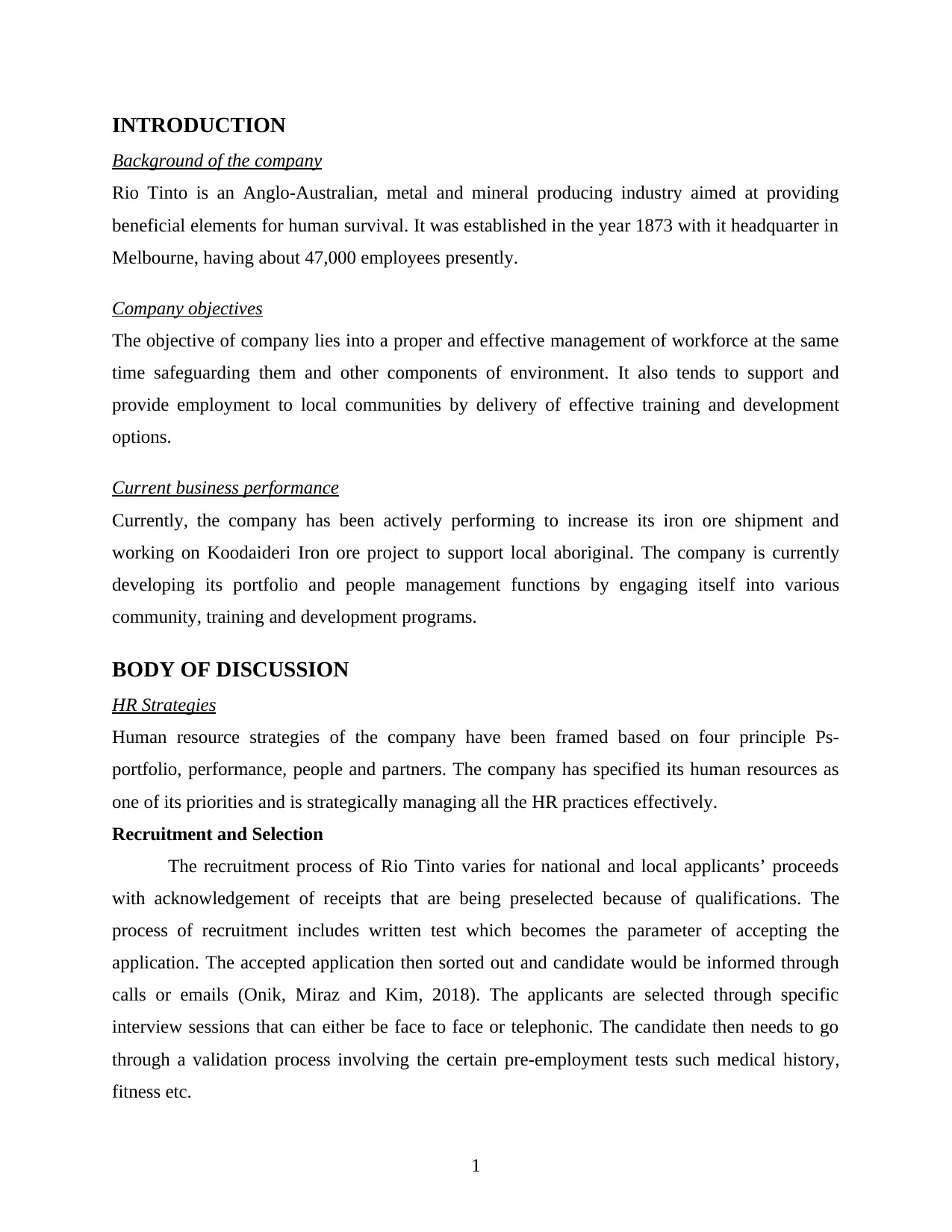
INTRODUCTION
Background of the company
Rio Tinto is an Anglo-Australian, metal and mineral producing industry aimed at providing
beneficial elements for human survival. It was established in the year 1873 with it headquarter in
Melbourne, having about 47,000 employees presently.
Company objectives
The objective of company lies into a proper and effective management of workforce at the same
time safeguarding them and other components of environment. It also tends to support and
provide employment to local communities by delivery of effective training and development
options.
Current business performance
Currently, the company has been actively performing to increase its iron ore shipment and
working on Koodaideri Iron ore project to support local aboriginal. The company is currently
developing its portfolio and people management functions by engaging itself into various
community, training and development programs.
BODY OF DISCUSSION
HR Strategies
Human resource strategies of the company have been framed based on four principle Ps-
portfolio, performance, people and partners. The company has specified its human resources as
one of its priorities and is strategically managing all the HR practices effectively.
Recruitment and Selection
The recruitment process of Rio Tinto varies for national and local applicants’ proceeds
with acknowledgement of receipts that are being preselected because of qualifications. The
process of recruitment includes written test which becomes the parameter of accepting the
application. The accepted application then sorted out and candidate would be informed through
calls or emails (Onik, Miraz and Kim, 2018). The applicants are selected through specific
interview sessions that can either be face to face or telephonic. The candidate then needs to go
through a validation process involving the certain pre-employment tests such medical history,
fitness etc.
1
Background of the company
Rio Tinto is an Anglo-Australian, metal and mineral producing industry aimed at providing
beneficial elements for human survival. It was established in the year 1873 with it headquarter in
Melbourne, having about 47,000 employees presently.
Company objectives
The objective of company lies into a proper and effective management of workforce at the same
time safeguarding them and other components of environment. It also tends to support and
provide employment to local communities by delivery of effective training and development
options.
Current business performance
Currently, the company has been actively performing to increase its iron ore shipment and
working on Koodaideri Iron ore project to support local aboriginal. The company is currently
developing its portfolio and people management functions by engaging itself into various
community, training and development programs.
BODY OF DISCUSSION
HR Strategies
Human resource strategies of the company have been framed based on four principle Ps-
portfolio, performance, people and partners. The company has specified its human resources as
one of its priorities and is strategically managing all the HR practices effectively.
Recruitment and Selection
The recruitment process of Rio Tinto varies for national and local applicants’ proceeds
with acknowledgement of receipts that are being preselected because of qualifications. The
process of recruitment includes written test which becomes the parameter of accepting the
application. The accepted application then sorted out and candidate would be informed through
calls or emails (Onik, Miraz and Kim, 2018). The applicants are selected through specific
interview sessions that can either be face to face or telephonic. The candidate then needs to go
through a validation process involving the certain pre-employment tests such medical history,
fitness etc.
1
⊘ This is a preview!⊘
Do you want full access?
Subscribe today to unlock all pages.

Trusted by 1+ million students worldwide
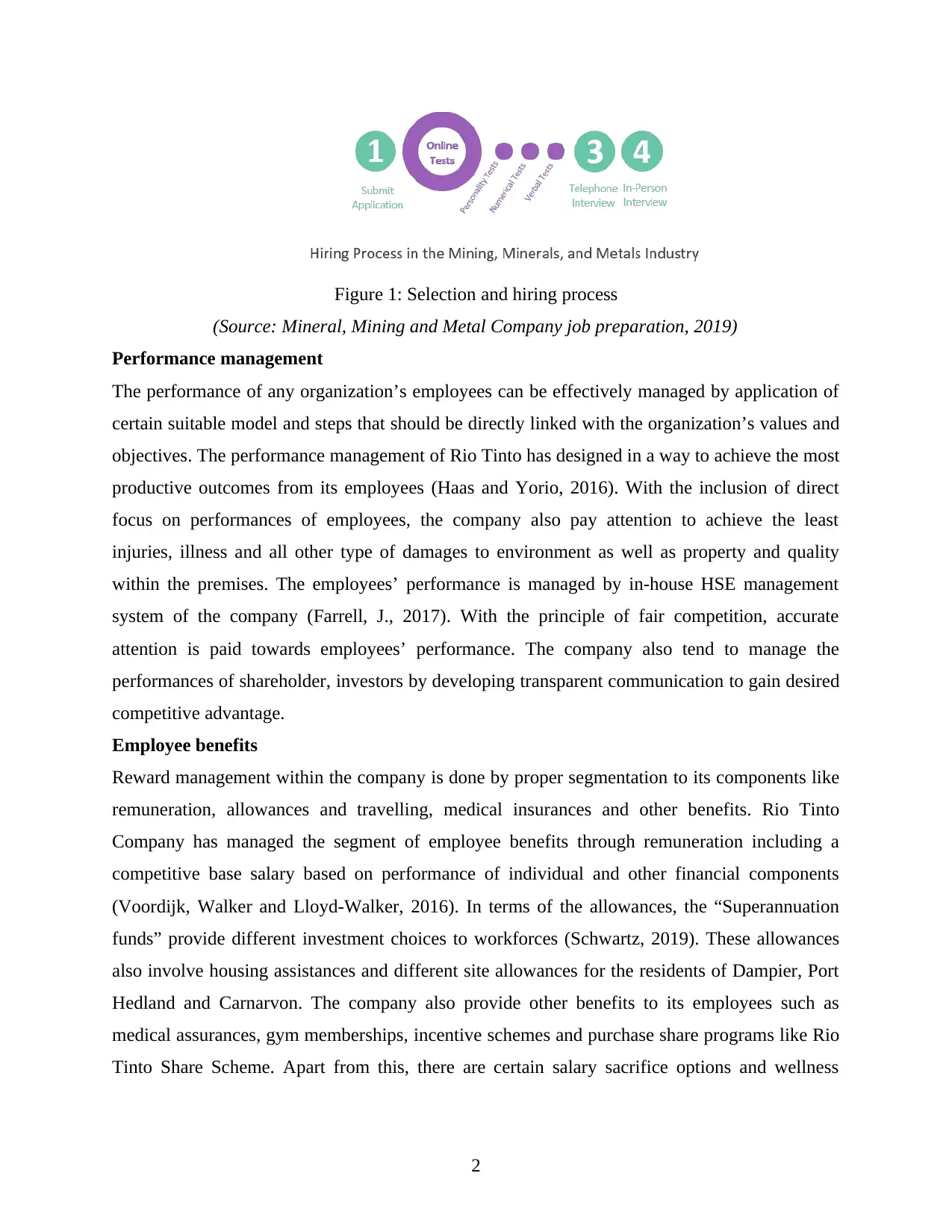
Figure 1: Selection and hiring process
(Source: Mineral, Mining and Metal Company job preparation, 2019)
Performance management
The performance of any organization’s employees can be effectively managed by application of
certain suitable model and steps that should be directly linked with the organization’s values and
objectives. The performance management of Rio Tinto has designed in a way to achieve the most
productive outcomes from its employees (Haas and Yorio, 2016). With the inclusion of direct
focus on performances of employees, the company also pay attention to achieve the least
injuries, illness and all other type of damages to environment as well as property and quality
within the premises. The employees’ performance is managed by in-house HSE management
system of the company (Farrell, J., 2017). With the principle of fair competition, accurate
attention is paid towards employees’ performance. The company also tend to manage the
performances of shareholder, investors by developing transparent communication to gain desired
competitive advantage.
Employee benefits
Reward management within the company is done by proper segmentation to its components like
remuneration, allowances and travelling, medical insurances and other benefits. Rio Tinto
Company has managed the segment of employee benefits through remuneration including a
competitive base salary based on performance of individual and other financial components
(Voordijk, Walker and Lloyd-Walker, 2016). In terms of the allowances, the “Superannuation
funds” provide different investment choices to workforces (Schwartz, 2019). These allowances
also involve housing assistances and different site allowances for the residents of Dampier, Port
Hedland and Carnarvon. The company also provide other benefits to its employees such as
medical assurances, gym memberships, incentive schemes and purchase share programs like Rio
Tinto Share Scheme. Apart from this, there are certain salary sacrifice options and wellness
2
(Source: Mineral, Mining and Metal Company job preparation, 2019)
Performance management
The performance of any organization’s employees can be effectively managed by application of
certain suitable model and steps that should be directly linked with the organization’s values and
objectives. The performance management of Rio Tinto has designed in a way to achieve the most
productive outcomes from its employees (Haas and Yorio, 2016). With the inclusion of direct
focus on performances of employees, the company also pay attention to achieve the least
injuries, illness and all other type of damages to environment as well as property and quality
within the premises. The employees’ performance is managed by in-house HSE management
system of the company (Farrell, J., 2017). With the principle of fair competition, accurate
attention is paid towards employees’ performance. The company also tend to manage the
performances of shareholder, investors by developing transparent communication to gain desired
competitive advantage.
Employee benefits
Reward management within the company is done by proper segmentation to its components like
remuneration, allowances and travelling, medical insurances and other benefits. Rio Tinto
Company has managed the segment of employee benefits through remuneration including a
competitive base salary based on performance of individual and other financial components
(Voordijk, Walker and Lloyd-Walker, 2016). In terms of the allowances, the “Superannuation
funds” provide different investment choices to workforces (Schwartz, 2019). These allowances
also involve housing assistances and different site allowances for the residents of Dampier, Port
Hedland and Carnarvon. The company also provide other benefits to its employees such as
medical assurances, gym memberships, incentive schemes and purchase share programs like Rio
Tinto Share Scheme. Apart from this, there are certain salary sacrifice options and wellness
2
Paraphrase This Document
Need a fresh take? Get an instant paraphrase of this document with our AI Paraphraser
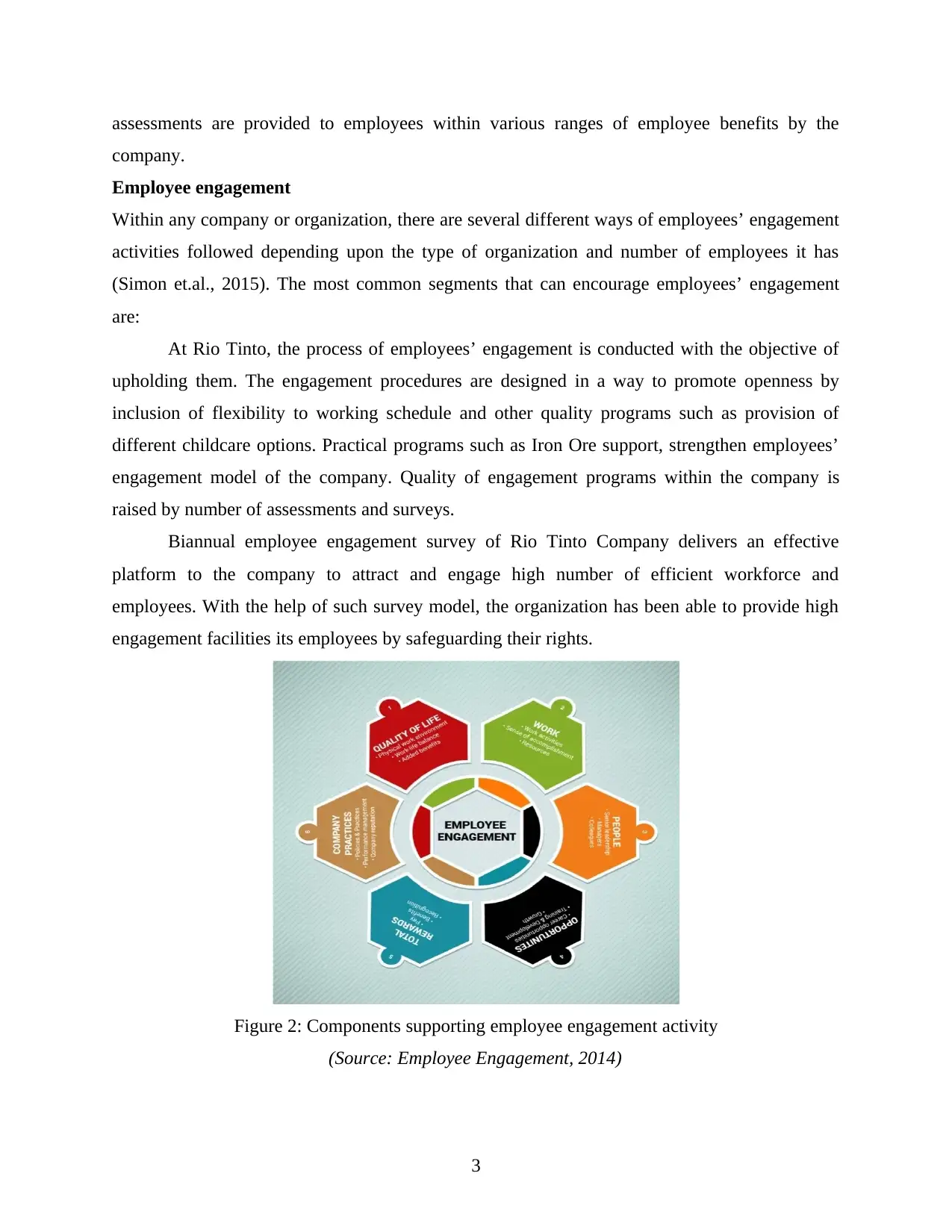
assessments are provided to employees within various ranges of employee benefits by the
company.
Employee engagement
Within any company or organization, there are several different ways of employees’ engagement
activities followed depending upon the type of organization and number of employees it has
(Simon et.al., 2015). The most common segments that can encourage employees’ engagement
are:
At Rio Tinto, the process of employees’ engagement is conducted with the objective of
upholding them. The engagement procedures are designed in a way to promote openness by
inclusion of flexibility to working schedule and other quality programs such as provision of
different childcare options. Practical programs such as Iron Ore support, strengthen employees’
engagement model of the company. Quality of engagement programs within the company is
raised by number of assessments and surveys.
Biannual employee engagement survey of Rio Tinto Company delivers an effective
platform to the company to attract and engage high number of efficient workforce and
employees. With the help of such survey model, the organization has been able to provide high
engagement facilities its employees by safeguarding their rights.
Figure 2: Components supporting employee engagement activity
(Source: Employee Engagement, 2014)
3
company.
Employee engagement
Within any company or organization, there are several different ways of employees’ engagement
activities followed depending upon the type of organization and number of employees it has
(Simon et.al., 2015). The most common segments that can encourage employees’ engagement
are:
At Rio Tinto, the process of employees’ engagement is conducted with the objective of
upholding them. The engagement procedures are designed in a way to promote openness by
inclusion of flexibility to working schedule and other quality programs such as provision of
different childcare options. Practical programs such as Iron Ore support, strengthen employees’
engagement model of the company. Quality of engagement programs within the company is
raised by number of assessments and surveys.
Biannual employee engagement survey of Rio Tinto Company delivers an effective
platform to the company to attract and engage high number of efficient workforce and
employees. With the help of such survey model, the organization has been able to provide high
engagement facilities its employees by safeguarding their rights.
Figure 2: Components supporting employee engagement activity
(Source: Employee Engagement, 2014)
3
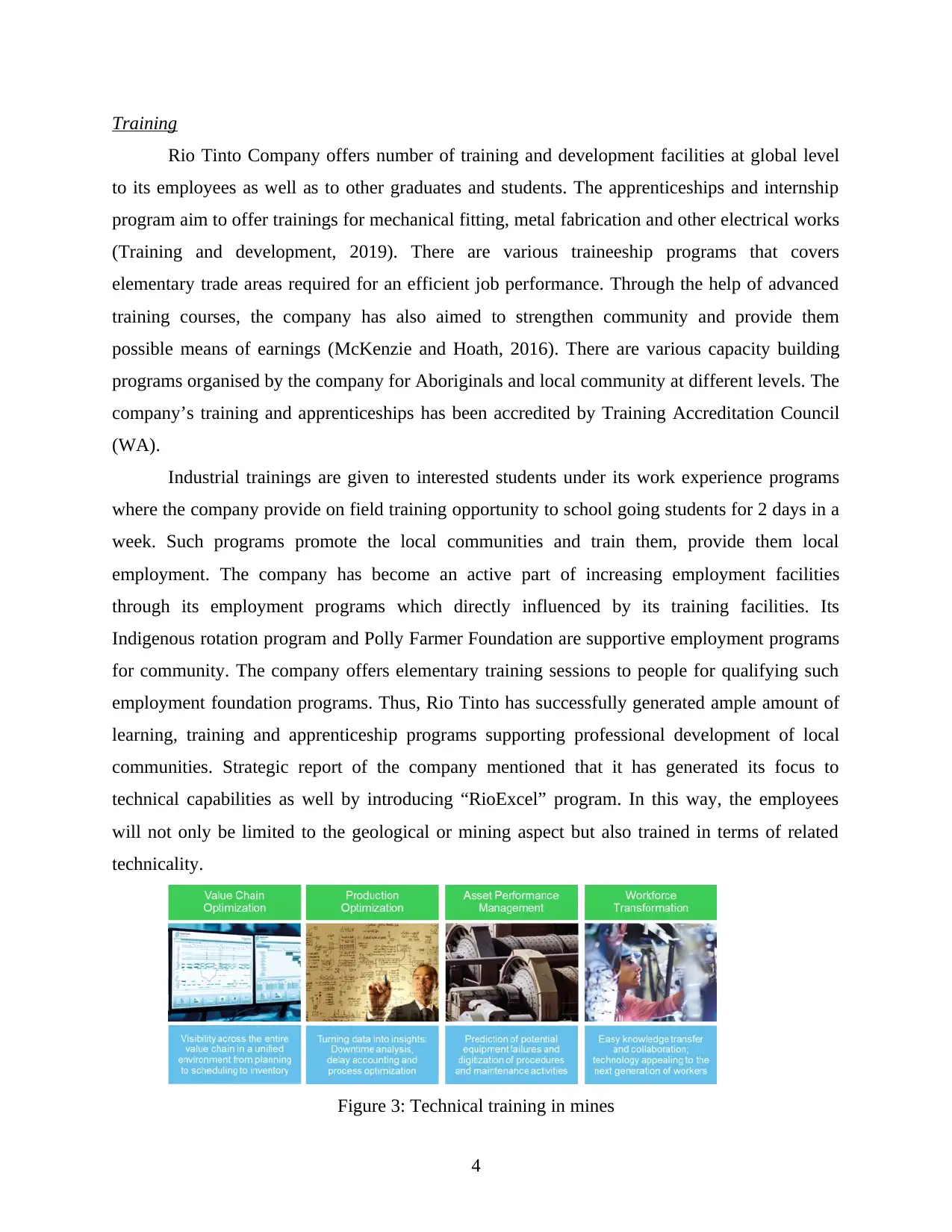
Training
Rio Tinto Company offers number of training and development facilities at global level
to its employees as well as to other graduates and students. The apprenticeships and internship
program aim to offer trainings for mechanical fitting, metal fabrication and other electrical works
(Training and development, 2019). There are various traineeship programs that covers
elementary trade areas required for an efficient job performance. Through the help of advanced
training courses, the company has also aimed to strengthen community and provide them
possible means of earnings (McKenzie and Hoath, 2016). There are various capacity building
programs organised by the company for Aboriginals and local community at different levels. The
company’s training and apprenticeships has been accredited by Training Accreditation Council
(WA).
Industrial trainings are given to interested students under its work experience programs
where the company provide on field training opportunity to school going students for 2 days in a
week. Such programs promote the local communities and train them, provide them local
employment. The company has become an active part of increasing employment facilities
through its employment programs which directly influenced by its training facilities. Its
Indigenous rotation program and Polly Farmer Foundation are supportive employment programs
for community. The company offers elementary training sessions to people for qualifying such
employment foundation programs. Thus, Rio Tinto has successfully generated ample amount of
learning, training and apprenticeship programs supporting professional development of local
communities. Strategic report of the company mentioned that it has generated its focus to
technical capabilities as well by introducing “RioExcel” program. In this way, the employees
will not only be limited to the geological or mining aspect but also trained in terms of related
technicality.
Figure 3: Technical training in mines
4
Rio Tinto Company offers number of training and development facilities at global level
to its employees as well as to other graduates and students. The apprenticeships and internship
program aim to offer trainings for mechanical fitting, metal fabrication and other electrical works
(Training and development, 2019). There are various traineeship programs that covers
elementary trade areas required for an efficient job performance. Through the help of advanced
training courses, the company has also aimed to strengthen community and provide them
possible means of earnings (McKenzie and Hoath, 2016). There are various capacity building
programs organised by the company for Aboriginals and local community at different levels. The
company’s training and apprenticeships has been accredited by Training Accreditation Council
(WA).
Industrial trainings are given to interested students under its work experience programs
where the company provide on field training opportunity to school going students for 2 days in a
week. Such programs promote the local communities and train them, provide them local
employment. The company has become an active part of increasing employment facilities
through its employment programs which directly influenced by its training facilities. Its
Indigenous rotation program and Polly Farmer Foundation are supportive employment programs
for community. The company offers elementary training sessions to people for qualifying such
employment foundation programs. Thus, Rio Tinto has successfully generated ample amount of
learning, training and apprenticeship programs supporting professional development of local
communities. Strategic report of the company mentioned that it has generated its focus to
technical capabilities as well by introducing “RioExcel” program. In this way, the employees
will not only be limited to the geological or mining aspect but also trained in terms of related
technicality.
Figure 3: Technical training in mines
4
⊘ This is a preview!⊘
Do you want full access?
Subscribe today to unlock all pages.

Trusted by 1+ million students worldwide
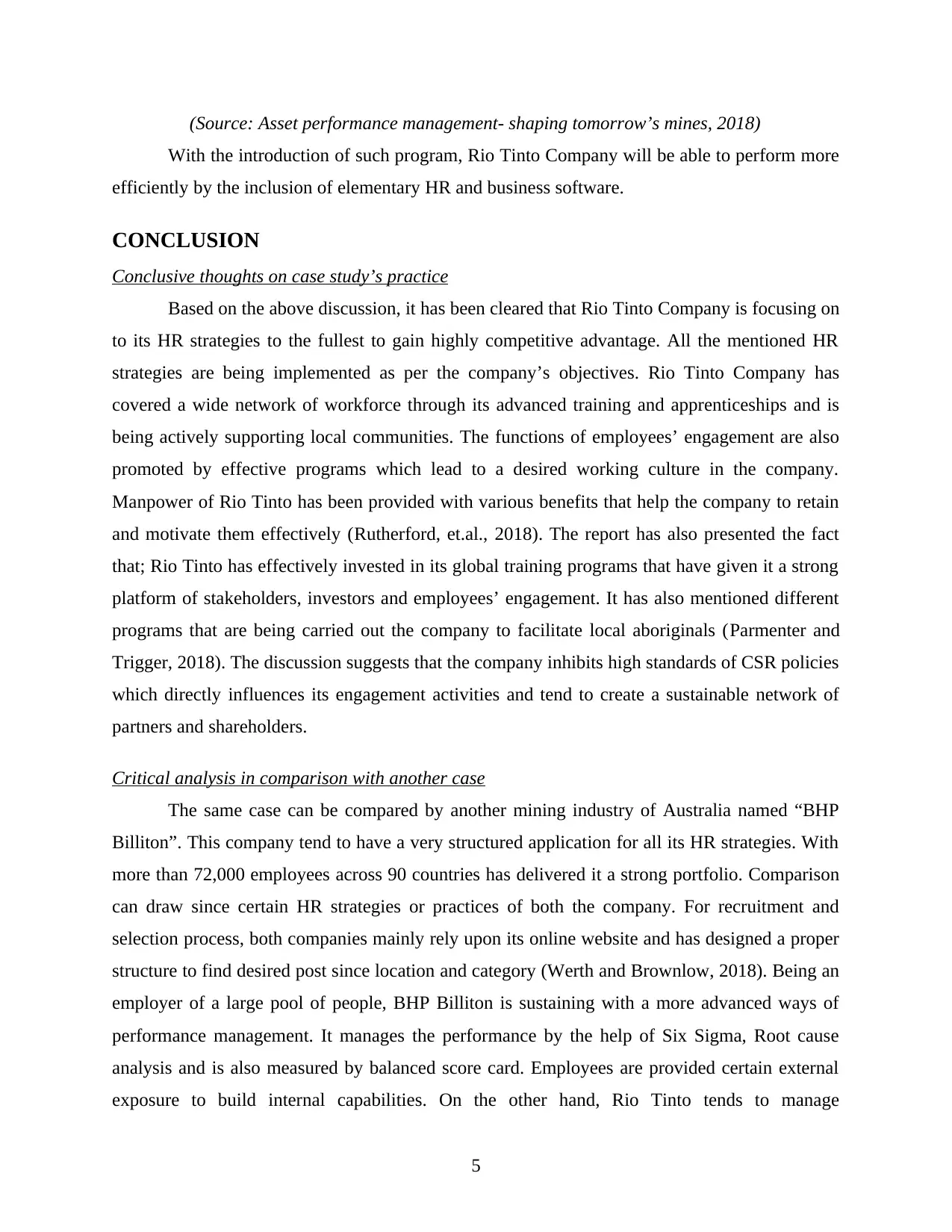
(Source: Asset performance management- shaping tomorrow’s mines, 2018)
With the introduction of such program, Rio Tinto Company will be able to perform more
efficiently by the inclusion of elementary HR and business software.
CONCLUSION
Conclusive thoughts on case study’s practice
Based on the above discussion, it has been cleared that Rio Tinto Company is focusing on
to its HR strategies to the fullest to gain highly competitive advantage. All the mentioned HR
strategies are being implemented as per the company’s objectives. Rio Tinto Company has
covered a wide network of workforce through its advanced training and apprenticeships and is
being actively supporting local communities. The functions of employees’ engagement are also
promoted by effective programs which lead to a desired working culture in the company.
Manpower of Rio Tinto has been provided with various benefits that help the company to retain
and motivate them effectively (Rutherford, et.al., 2018). The report has also presented the fact
that; Rio Tinto has effectively invested in its global training programs that have given it a strong
platform of stakeholders, investors and employees’ engagement. It has also mentioned different
programs that are being carried out the company to facilitate local aboriginals (Parmenter and
Trigger, 2018). The discussion suggests that the company inhibits high standards of CSR policies
which directly influences its engagement activities and tend to create a sustainable network of
partners and shareholders.
Critical analysis in comparison with another case
The same case can be compared by another mining industry of Australia named “BHP
Billiton”. This company tend to have a very structured application for all its HR strategies. With
more than 72,000 employees across 90 countries has delivered it a strong portfolio. Comparison
can draw since certain HR strategies or practices of both the company. For recruitment and
selection process, both companies mainly rely upon its online website and has designed a proper
structure to find desired post since location and category (Werth and Brownlow, 2018). Being an
employer of a large pool of people, BHP Billiton is sustaining with a more advanced ways of
performance management. It manages the performance by the help of Six Sigma, Root cause
analysis and is also measured by balanced score card. Employees are provided certain external
exposure to build internal capabilities. On the other hand, Rio Tinto tends to manage
5
With the introduction of such program, Rio Tinto Company will be able to perform more
efficiently by the inclusion of elementary HR and business software.
CONCLUSION
Conclusive thoughts on case study’s practice
Based on the above discussion, it has been cleared that Rio Tinto Company is focusing on
to its HR strategies to the fullest to gain highly competitive advantage. All the mentioned HR
strategies are being implemented as per the company’s objectives. Rio Tinto Company has
covered a wide network of workforce through its advanced training and apprenticeships and is
being actively supporting local communities. The functions of employees’ engagement are also
promoted by effective programs which lead to a desired working culture in the company.
Manpower of Rio Tinto has been provided with various benefits that help the company to retain
and motivate them effectively (Rutherford, et.al., 2018). The report has also presented the fact
that; Rio Tinto has effectively invested in its global training programs that have given it a strong
platform of stakeholders, investors and employees’ engagement. It has also mentioned different
programs that are being carried out the company to facilitate local aboriginals (Parmenter and
Trigger, 2018). The discussion suggests that the company inhibits high standards of CSR policies
which directly influences its engagement activities and tend to create a sustainable network of
partners and shareholders.
Critical analysis in comparison with another case
The same case can be compared by another mining industry of Australia named “BHP
Billiton”. This company tend to have a very structured application for all its HR strategies. With
more than 72,000 employees across 90 countries has delivered it a strong portfolio. Comparison
can draw since certain HR strategies or practices of both the company. For recruitment and
selection process, both companies mainly rely upon its online website and has designed a proper
structure to find desired post since location and category (Werth and Brownlow, 2018). Being an
employer of a large pool of people, BHP Billiton is sustaining with a more advanced ways of
performance management. It manages the performance by the help of Six Sigma, Root cause
analysis and is also measured by balanced score card. Employees are provided certain external
exposure to build internal capabilities. On the other hand, Rio Tinto tends to manage
5
Paraphrase This Document
Need a fresh take? Get an instant paraphrase of this document with our AI Paraphraser
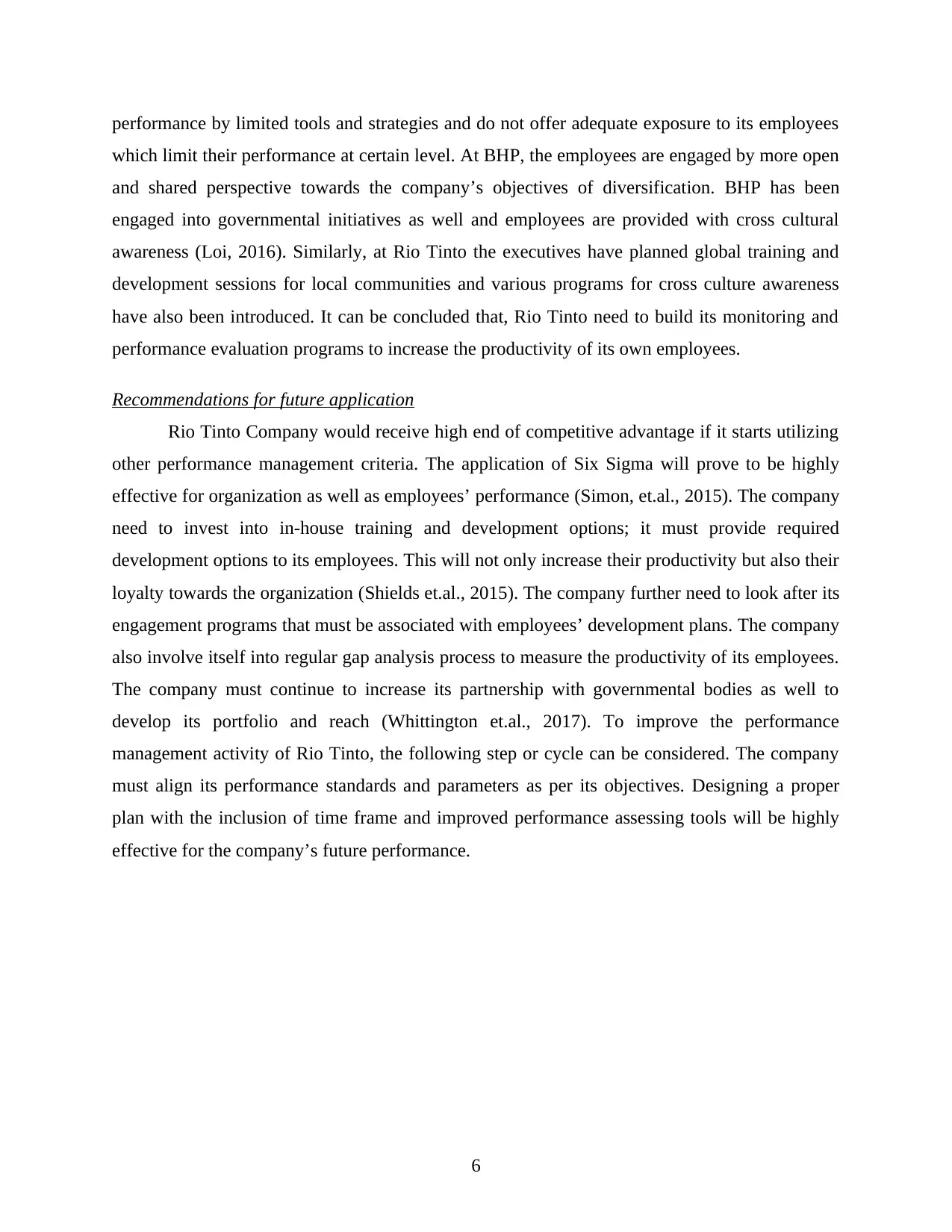
performance by limited tools and strategies and do not offer adequate exposure to its employees
which limit their performance at certain level. At BHP, the employees are engaged by more open
and shared perspective towards the company’s objectives of diversification. BHP has been
engaged into governmental initiatives as well and employees are provided with cross cultural
awareness (Loi, 2016). Similarly, at Rio Tinto the executives have planned global training and
development sessions for local communities and various programs for cross culture awareness
have also been introduced. It can be concluded that, Rio Tinto need to build its monitoring and
performance evaluation programs to increase the productivity of its own employees.
Recommendations for future application
Rio Tinto Company would receive high end of competitive advantage if it starts utilizing
other performance management criteria. The application of Six Sigma will prove to be highly
effective for organization as well as employees’ performance (Simon, et.al., 2015). The company
need to invest into in-house training and development options; it must provide required
development options to its employees. This will not only increase their productivity but also their
loyalty towards the organization (Shields et.al., 2015). The company further need to look after its
engagement programs that must be associated with employees’ development plans. The company
also involve itself into regular gap analysis process to measure the productivity of its employees.
The company must continue to increase its partnership with governmental bodies as well to
develop its portfolio and reach (Whittington et.al., 2017). To improve the performance
management activity of Rio Tinto, the following step or cycle can be considered. The company
must align its performance standards and parameters as per its objectives. Designing a proper
plan with the inclusion of time frame and improved performance assessing tools will be highly
effective for the company’s future performance.
6
which limit their performance at certain level. At BHP, the employees are engaged by more open
and shared perspective towards the company’s objectives of diversification. BHP has been
engaged into governmental initiatives as well and employees are provided with cross cultural
awareness (Loi, 2016). Similarly, at Rio Tinto the executives have planned global training and
development sessions for local communities and various programs for cross culture awareness
have also been introduced. It can be concluded that, Rio Tinto need to build its monitoring and
performance evaluation programs to increase the productivity of its own employees.
Recommendations for future application
Rio Tinto Company would receive high end of competitive advantage if it starts utilizing
other performance management criteria. The application of Six Sigma will prove to be highly
effective for organization as well as employees’ performance (Simon, et.al., 2015). The company
need to invest into in-house training and development options; it must provide required
development options to its employees. This will not only increase their productivity but also their
loyalty towards the organization (Shields et.al., 2015). The company further need to look after its
engagement programs that must be associated with employees’ development plans. The company
also involve itself into regular gap analysis process to measure the productivity of its employees.
The company must continue to increase its partnership with governmental bodies as well to
develop its portfolio and reach (Whittington et.al., 2017). To improve the performance
management activity of Rio Tinto, the following step or cycle can be considered. The company
must align its performance standards and parameters as per its objectives. Designing a proper
plan with the inclusion of time frame and improved performance assessing tools will be highly
effective for the company’s future performance.
6
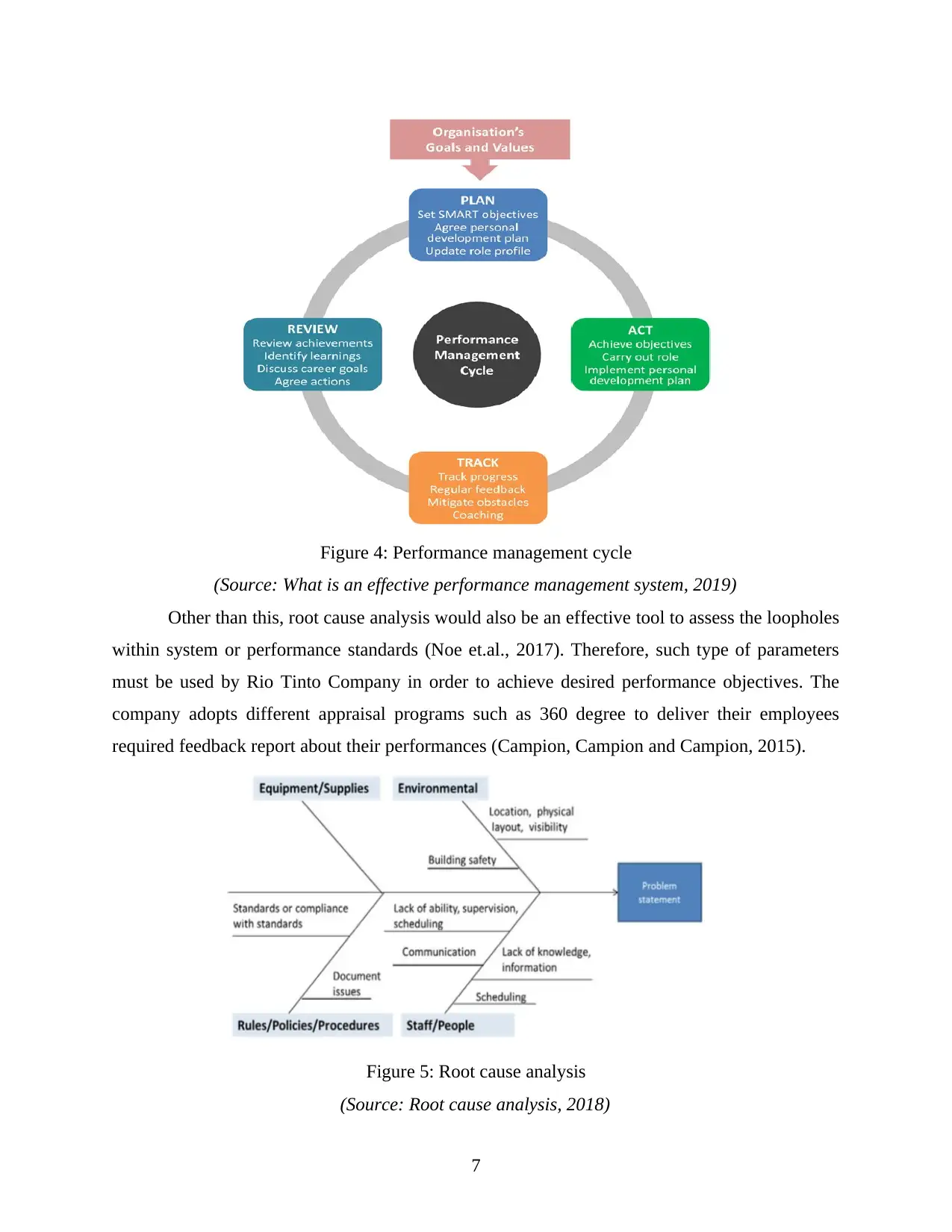
Figure 4: Performance management cycle
(Source: What is an effective performance management system, 2019)
Other than this, root cause analysis would also be an effective tool to assess the loopholes
within system or performance standards (Noe et.al., 2017). Therefore, such type of parameters
must be used by Rio Tinto Company in order to achieve desired performance objectives. The
company adopts different appraisal programs such as 360 degree to deliver their employees
required feedback report about their performances (Campion, Campion and Campion, 2015).
Figure 5: Root cause analysis
(Source: Root cause analysis, 2018)
7
(Source: What is an effective performance management system, 2019)
Other than this, root cause analysis would also be an effective tool to assess the loopholes
within system or performance standards (Noe et.al., 2017). Therefore, such type of parameters
must be used by Rio Tinto Company in order to achieve desired performance objectives. The
company adopts different appraisal programs such as 360 degree to deliver their employees
required feedback report about their performances (Campion, Campion and Campion, 2015).
Figure 5: Root cause analysis
(Source: Root cause analysis, 2018)
7
⊘ This is a preview!⊘
Do you want full access?
Subscribe today to unlock all pages.

Trusted by 1+ million students worldwide
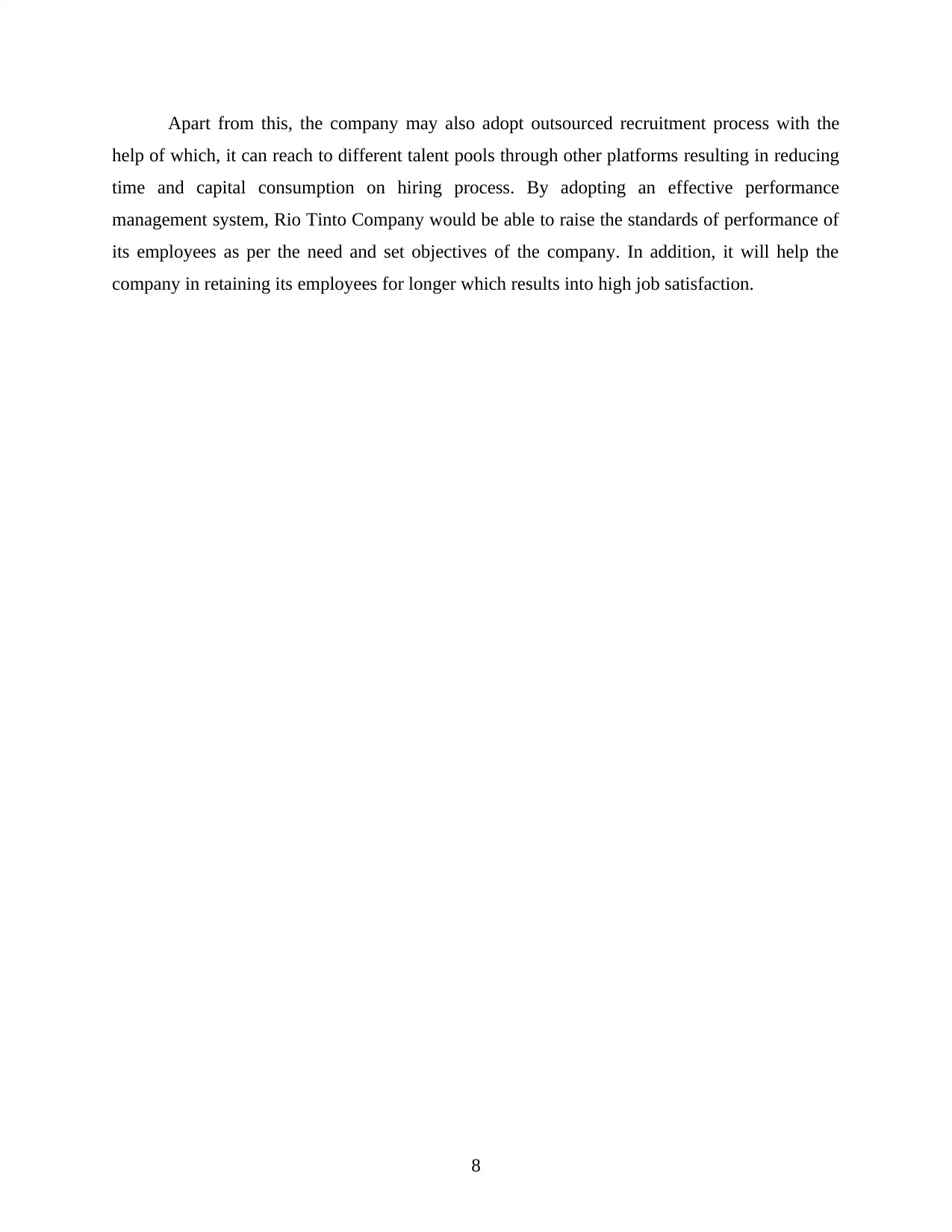
Apart from this, the company may also adopt outsourced recruitment process with the
help of which, it can reach to different talent pools through other platforms resulting in reducing
time and capital consumption on hiring process. By adopting an effective performance
management system, Rio Tinto Company would be able to raise the standards of performance of
its employees as per the need and set objectives of the company. In addition, it will help the
company in retaining its employees for longer which results into high job satisfaction.
8
help of which, it can reach to different talent pools through other platforms resulting in reducing
time and capital consumption on hiring process. By adopting an effective performance
management system, Rio Tinto Company would be able to raise the standards of performance of
its employees as per the need and set objectives of the company. In addition, it will help the
company in retaining its employees for longer which results into high job satisfaction.
8
Paraphrase This Document
Need a fresh take? Get an instant paraphrase of this document with our AI Paraphraser
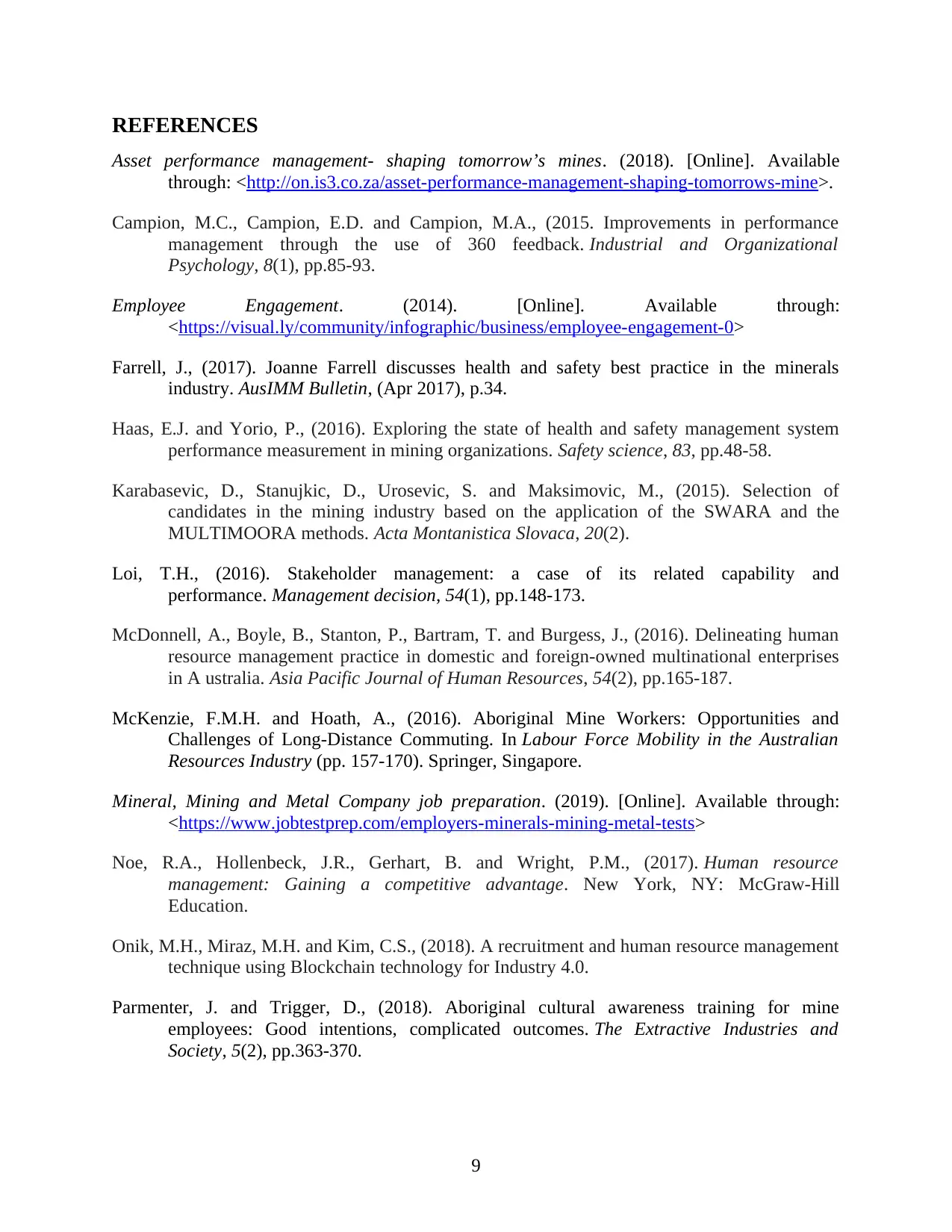
REFERENCES
Asset performance management- shaping tomorrow’s mines. (2018). [Online]. Available
through: <http://on.is3.co.za/asset-performance-management-shaping-tomorrows-mine>.
Campion, M.C., Campion, E.D. and Campion, M.A., (2015. Improvements in performance
management through the use of 360 feedback. Industrial and Organizational
Psychology, 8(1), pp.85-93.
Employee Engagement. (2014). [Online]. Available through:
<https://visual.ly/community/infographic/business/employee-engagement-0>
Farrell, J., (2017). Joanne Farrell discusses health and safety best practice in the minerals
industry. AusIMM Bulletin, (Apr 2017), p.34.
Haas, E.J. and Yorio, P., (2016). Exploring the state of health and safety management system
performance measurement in mining organizations. Safety science, 83, pp.48-58.
Karabasevic, D., Stanujkic, D., Urosevic, S. and Maksimovic, M., (2015). Selection of
candidates in the mining industry based on the application of the SWARA and the
MULTIMOORA methods. Acta Montanistica Slovaca, 20(2).
Loi, T.H., (2016). Stakeholder management: a case of its related capability and
performance. Management decision, 54(1), pp.148-173.
McDonnell, A., Boyle, B., Stanton, P., Bartram, T. and Burgess, J., (2016). Delineating human
resource management practice in domestic and foreign‐owned multinational enterprises
in A ustralia. Asia Pacific Journal of Human Resources, 54(2), pp.165-187.
McKenzie, F.M.H. and Hoath, A., (2016). Aboriginal Mine Workers: Opportunities and
Challenges of Long-Distance Commuting. In Labour Force Mobility in the Australian
Resources Industry (pp. 157-170). Springer, Singapore.
Mineral, Mining and Metal Company job preparation. (2019). [Online]. Available through:
<https://www.jobtestprep.com/employers-minerals-mining-metal-tests>
Noe, R.A., Hollenbeck, J.R., Gerhart, B. and Wright, P.M., (2017). Human resource
management: Gaining a competitive advantage. New York, NY: McGraw-Hill
Education.
Onik, M.H., Miraz, M.H. and Kim, C.S., (2018). A recruitment and human resource management
technique using Blockchain technology for Industry 4.0.
Parmenter, J. and Trigger, D., (2018). Aboriginal cultural awareness training for mine
employees: Good intentions, complicated outcomes. The Extractive Industries and
Society, 5(2), pp.363-370.
9
Asset performance management- shaping tomorrow’s mines. (2018). [Online]. Available
through: <http://on.is3.co.za/asset-performance-management-shaping-tomorrows-mine>.
Campion, M.C., Campion, E.D. and Campion, M.A., (2015. Improvements in performance
management through the use of 360 feedback. Industrial and Organizational
Psychology, 8(1), pp.85-93.
Employee Engagement. (2014). [Online]. Available through:
<https://visual.ly/community/infographic/business/employee-engagement-0>
Farrell, J., (2017). Joanne Farrell discusses health and safety best practice in the minerals
industry. AusIMM Bulletin, (Apr 2017), p.34.
Haas, E.J. and Yorio, P., (2016). Exploring the state of health and safety management system
performance measurement in mining organizations. Safety science, 83, pp.48-58.
Karabasevic, D., Stanujkic, D., Urosevic, S. and Maksimovic, M., (2015). Selection of
candidates in the mining industry based on the application of the SWARA and the
MULTIMOORA methods. Acta Montanistica Slovaca, 20(2).
Loi, T.H., (2016). Stakeholder management: a case of its related capability and
performance. Management decision, 54(1), pp.148-173.
McDonnell, A., Boyle, B., Stanton, P., Bartram, T. and Burgess, J., (2016). Delineating human
resource management practice in domestic and foreign‐owned multinational enterprises
in A ustralia. Asia Pacific Journal of Human Resources, 54(2), pp.165-187.
McKenzie, F.M.H. and Hoath, A., (2016). Aboriginal Mine Workers: Opportunities and
Challenges of Long-Distance Commuting. In Labour Force Mobility in the Australian
Resources Industry (pp. 157-170). Springer, Singapore.
Mineral, Mining and Metal Company job preparation. (2019). [Online]. Available through:
<https://www.jobtestprep.com/employers-minerals-mining-metal-tests>
Noe, R.A., Hollenbeck, J.R., Gerhart, B. and Wright, P.M., (2017). Human resource
management: Gaining a competitive advantage. New York, NY: McGraw-Hill
Education.
Onik, M.H., Miraz, M.H. and Kim, C.S., (2018). A recruitment and human resource management
technique using Blockchain technology for Industry 4.0.
Parmenter, J. and Trigger, D., (2018). Aboriginal cultural awareness training for mine
employees: Good intentions, complicated outcomes. The Extractive Industries and
Society, 5(2), pp.363-370.
9
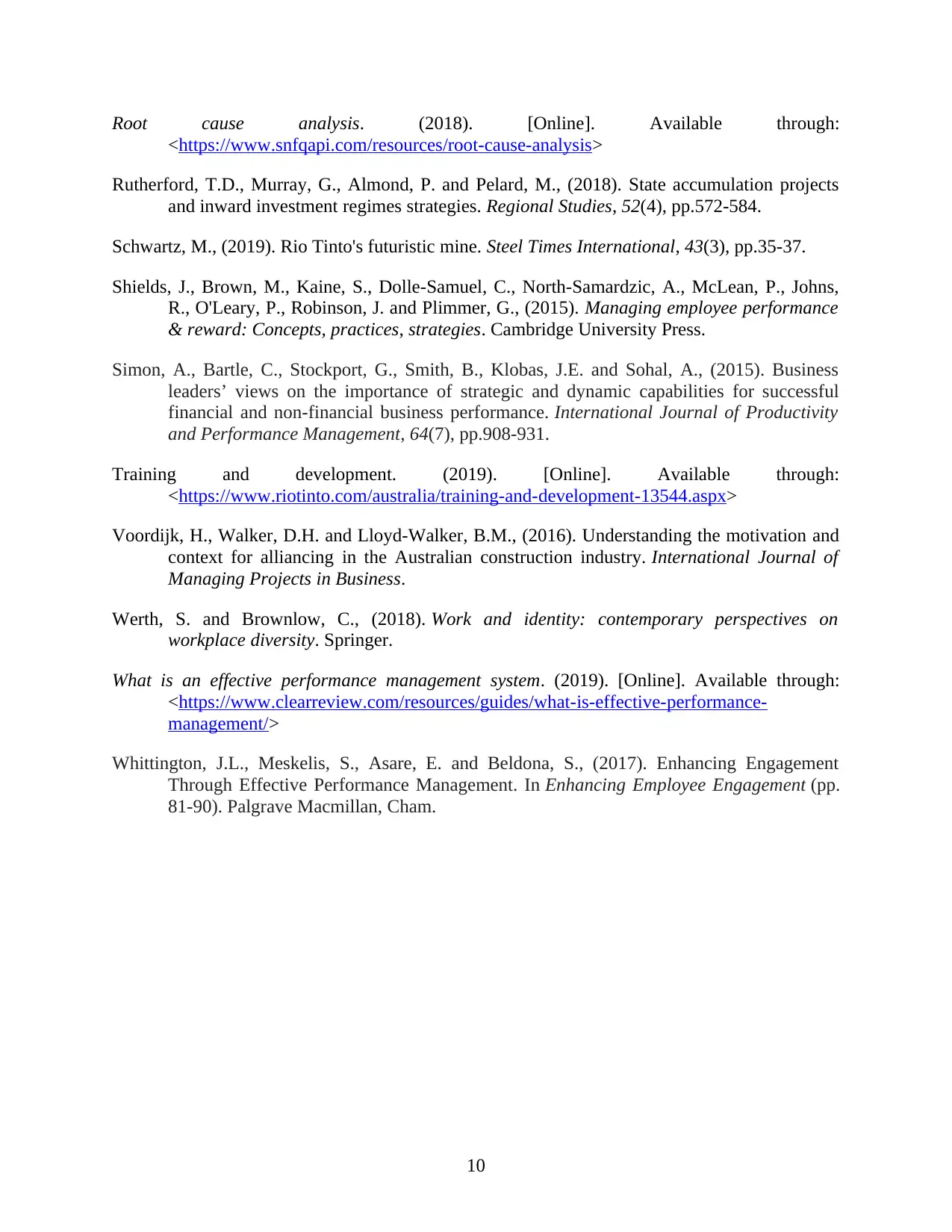
Root cause analysis. (2018). [Online]. Available through:
<https://www.snfqapi.com/resources/root-cause-analysis>
Rutherford, T.D., Murray, G., Almond, P. and Pelard, M., (2018). State accumulation projects
and inward investment regimes strategies. Regional Studies, 52(4), pp.572-584.
Schwartz, M., (2019). Rio Tinto's futuristic mine. Steel Times International, 43(3), pp.35-37.
Shields, J., Brown, M., Kaine, S., Dolle-Samuel, C., North-Samardzic, A., McLean, P., Johns,
R., O'Leary, P., Robinson, J. and Plimmer, G., (2015). Managing employee performance
& reward: Concepts, practices, strategies. Cambridge University Press.
Simon, A., Bartle, C., Stockport, G., Smith, B., Klobas, J.E. and Sohal, A., (2015). Business
leaders’ views on the importance of strategic and dynamic capabilities for successful
financial and non-financial business performance. International Journal of Productivity
and Performance Management, 64(7), pp.908-931.
Training and development. (2019). [Online]. Available through:
<https://www.riotinto.com/australia/training-and-development-13544.aspx>
Voordijk, H., Walker, D.H. and Lloyd-Walker, B.M., (2016). Understanding the motivation and
context for alliancing in the Australian construction industry. International Journal of
Managing Projects in Business.
Werth, S. and Brownlow, C., (2018). Work and identity: contemporary perspectives on
workplace diversity. Springer.
What is an effective performance management system. (2019). [Online]. Available through:
<https://www.clearreview.com/resources/guides/what-is-effective-performance-
management/>
Whittington, J.L., Meskelis, S., Asare, E. and Beldona, S., (2017). Enhancing Engagement
Through Effective Performance Management. In Enhancing Employee Engagement (pp.
81-90). Palgrave Macmillan, Cham.
10
<https://www.snfqapi.com/resources/root-cause-analysis>
Rutherford, T.D., Murray, G., Almond, P. and Pelard, M., (2018). State accumulation projects
and inward investment regimes strategies. Regional Studies, 52(4), pp.572-584.
Schwartz, M., (2019). Rio Tinto's futuristic mine. Steel Times International, 43(3), pp.35-37.
Shields, J., Brown, M., Kaine, S., Dolle-Samuel, C., North-Samardzic, A., McLean, P., Johns,
R., O'Leary, P., Robinson, J. and Plimmer, G., (2015). Managing employee performance
& reward: Concepts, practices, strategies. Cambridge University Press.
Simon, A., Bartle, C., Stockport, G., Smith, B., Klobas, J.E. and Sohal, A., (2015). Business
leaders’ views on the importance of strategic and dynamic capabilities for successful
financial and non-financial business performance. International Journal of Productivity
and Performance Management, 64(7), pp.908-931.
Training and development. (2019). [Online]. Available through:
<https://www.riotinto.com/australia/training-and-development-13544.aspx>
Voordijk, H., Walker, D.H. and Lloyd-Walker, B.M., (2016). Understanding the motivation and
context for alliancing in the Australian construction industry. International Journal of
Managing Projects in Business.
Werth, S. and Brownlow, C., (2018). Work and identity: contemporary perspectives on
workplace diversity. Springer.
What is an effective performance management system. (2019). [Online]. Available through:
<https://www.clearreview.com/resources/guides/what-is-effective-performance-
management/>
Whittington, J.L., Meskelis, S., Asare, E. and Beldona, S., (2017). Enhancing Engagement
Through Effective Performance Management. In Enhancing Employee Engagement (pp.
81-90). Palgrave Macmillan, Cham.
10
⊘ This is a preview!⊘
Do you want full access?
Subscribe today to unlock all pages.

Trusted by 1+ million students worldwide
1 out of 12
Related Documents
Your All-in-One AI-Powered Toolkit for Academic Success.
+13062052269
info@desklib.com
Available 24*7 on WhatsApp / Email
![[object Object]](/_next/static/media/star-bottom.7253800d.svg)
Unlock your academic potential
Copyright © 2020–2025 A2Z Services. All Rights Reserved. Developed and managed by ZUCOL.





